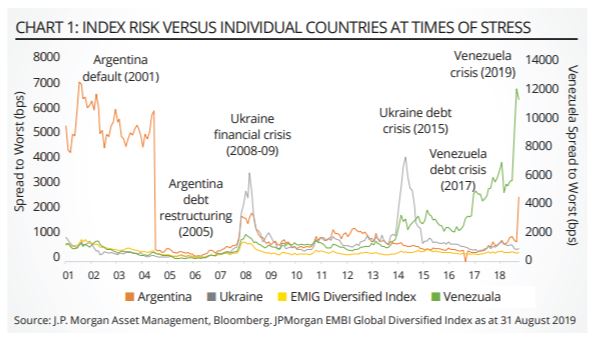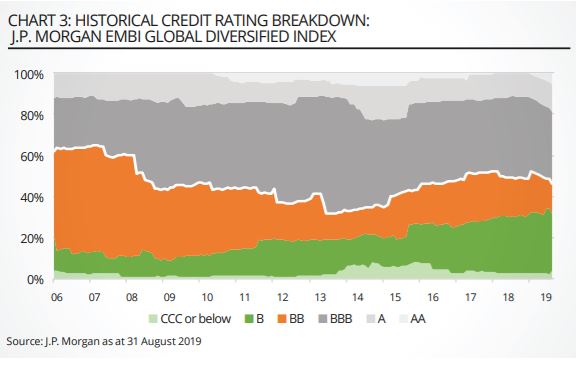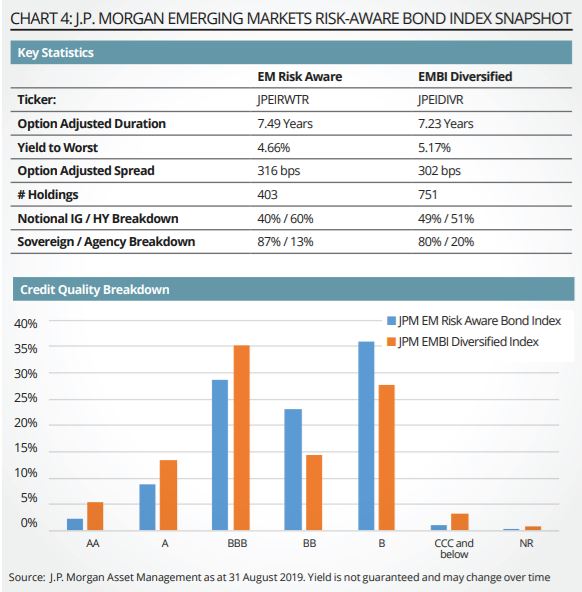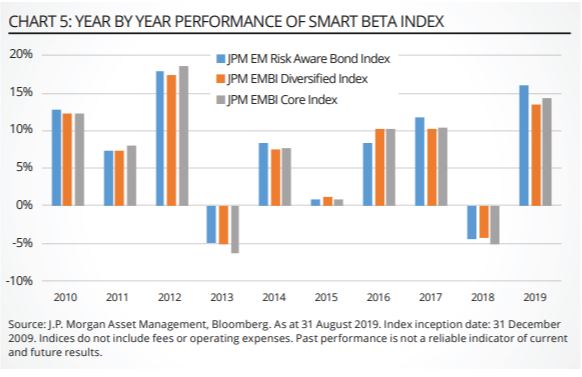Investing in traditional debt-weighted fixed income indices comes with challenges, which can be particularly pronounced in emerging markets. JP Morgan Asset Management examines a rules-based approach to address these challenges while still providing a core exposure to the asset class.
Allocating to emerging market debt
Investors are increasingly allocating to emerging market debt, attracted by diversification, higher yields on offer compared to developed market bonds, and the improving credit quality and fiscal strength of many emerging market sovereign issuers. While the asset class was down in 2018, it has rebounded significantly and is one of the strongest performing fixed income asset classes in 2019. Through the end of August 2019, a traditional hard currency sovereign index, the J.P. Morgan EMBI Global Diversified index, has returned 13.5% year-to-date.
Yet even in a market rally, emerging market debt investors still face many of the same challenges and concerns that are present throughout the cycle – namely idiosyncratic country risk and unstable credit risk exposure. As an example, in 2019, countries like Argentina and Venezuela have experienced challenges. The debt issued by these individual countries has lost between 35% and 45%
of its value year-to-date through August. This has had a negative impact on performance of the market, even as the broader asset class has been positive.
Here we examine systematic ways to improve upon these challenges. The research outlined here underpins the development of a proprietary “smart beta” index, the J.P. Morgan Emerging Market Risk Aware index (the EMRA index), which is tracked by J.P. Morgan Asset Management’s USD Emerging Markets Sovereign Bond UCITS ETF (JPMB).
In developing this index, rather than simply weighting constituents by debt-outstanding, we instead considered the investor’s experience and sought to address a few of key considerations most relevant to them: country-specific risk, credit exposure, and liquidity, while still providing a core exposure to the asset class.
Addressing country-specific risks
When investing in emerging market debt, drawdown and tail risk can at times be substantial.
This includes isolated country defaults as well as more systemic crises, where some countries significantly underperform.
In Chart 1, we compare the historical spread to-worst of the broad EMBI Global Diversified index with spreads for individual countries during times of stress. As shown, during episodes like the Argentinian Default in 2001, the Ukrainian Debt Crisis in 2015, and the Venezuelan Crises in 2017 and 2019, spreads on debt issued by individual countries can widen significantly and often abruptly.
While these spreads often contract after action is taken (for example, a debt restructuring or changes in policy), these periods lead to a significant increase in volatility for investors.

To address this challenge, we consider a quantitative risk filter. We begin with the EMBI Global Diversified index, a traditional and widely tracked USD-denominated sovereign debt index. Emerging market countries within that index are then ranked according to their relative risk level and the riskiest 10% of the index by market cap is discarded.
In determining relative risk, we use duration times-spread (DTS) as a metric, which has a number of benefits:
• DTS incorporates both the country’s spread as well as its sensitivity to changes in spread
• DTS is a good forward-looking measure: it provides a good ex-ante spread volatility forecast and successfully identifies the highest risk countries based on both volatility and tail risk
• Using DTS, rather than a more momentum-based measure, ensures that turnover is contained, thereby limiting transaction costs that would be incurred by the end investor and could be significant in emerging markets
To illustrate the benefit of this risk filter in practice, Chart 2 shows the cumulative return of a portfolio invested in the 10% of market cap of the highest risk countries – those countries with the highest DTS.

This portfolio is weighted by debt-outstanding and rebalanced semi-annually. We compare this to the returns of the J.P. Morgan EMRA index. As shown, while the overall returns are similar, the volatility of the highest risk countries is nearly three times as high.
Recent results: Countries in crisis
In 2019, even as the broad emerging market debt universe has rallied, this quantitative risk filter has added value. We examine two specific examples: Venezuela and Argentina.
Venezuela has been a dominant story in emerging markets in 2019, driven by political instability, sanctions, and humanitarian challenges. To begin the year, Venezuela made up roughly 1% of the traditional JPM EMBI Global Diversified index. Yet with a duration-times-spread (DTS) more than three times higher than the next riskiest country, has been consistently screened out by our quantitative risk filter since 2010.
Systematically avoiding this country has improved performance, with USD-denominated debt returning -35.7% year-to-date through 31 August 2019. However, this has also come with a few key additional benefits, including:
• Liquidity: following US sanctions, Venezuelan debt is no longer widely traded so owners of this debt will struggle to find buyers if they look to sell. After evaluating this lack of liquidity, leading index providers like J.P. Morgan have decided to phase Venezuela out of their indices over the course of the year. This means that in order to track the index, traditional passive asset managers may be forced to sell this debt at significantly lower prices.
• Yield: Venezuela is still included in the headline yield of the standard EMBI Global Diversified index, despite the fact that the country is in default. For example, as at the end of May 2019, the country made up less than 1% of the index market weight, yet it contributed nearly 10% of the index’s headline yield as Venezuelan debt “yielded” 62%.
• Volatility: Since Venezuelan debt is not widely traded, for part of the year, indices that included these bonds simply rolled the price on this debt, artificially understating the volatility of the index and not reflecting the underlying market dynamics. Argentina is another recent example of idiosyncratic country risk having an outsized impact on investor returns in 2019, with USD-denominated debt returning -45.5% year-to-date through August.
Following the surprising scale of the defeat of Argentina’s incumbent president Mauricio Macri in the first round of Argentina’s presidential election on 11 August, there have been significant and rapid moves in Argentinian assets. This reflects market perceptions of a likely shift towards a less market-friendly policy under a potential new government. Since then, the Argentine Peso has dropped in value by 22% vs. the US Dollar, CDS has widened by 2700bps, and USD-denominated bonds returned -51.5% in the month of August alone.
At the beginning of August, Argentina made up 2.3% of the traditional EMBI Diversified index, yet has been excluded via our quantitative risk filter for more than nine years. Simply avoiding an allocation to Argentina led to more than 1.2% of outperformance at the index level over a single month in August. This represents another strong illustration of the strategy avoiding some of the idiosyncratic issues associated with the highest risk countries, and thus reducing overall portfolio volatility for our clients.
Addressing credit risk
Another challenge of investing in traditional, debt-weighted indices is investors’ exposure is driven entirely by debt issuance patterns, rather than a desired investment outcome. This can lead to unstable credit ratings, unwanted interest rate sensitivity, or concentrations in areas of the market that are under-rewarded – simply because certain countries issue more or less debt.
Chart 3 illustrates this challenge in the hard currency emerging market debt market. In 2008, roughly 65% of the traditional J.P. Morgan EMBI Global Diversified index was rated high yield.

Fast forward to today and about half the index is investment grade. This variation in credit rating has been entirely driven by debt issuance patterns and is out of the control of traditional passive investors.
To help to manage these fluctuations in credit exposure, we consider a credit stabilisation approach. After removing the highest risk countries as described above, we then re-weight the index toward higher quality high yield issuers, seeking to maintain a consistent 75% risk contribution from high yield bonds and a 25% risk contribution from investment grade bonds. This approach leads to a number of benefits, for example:
• It provides investors with a more thoughtful and consistent exposure to credit and duration
• It aligns risk exposure to higher quality high yield, an area of the market where investors have historically been more compensated, while allowing the strategy to be managed in a UCITS compliant way
• It provides a yield that is similar to a traditional index. While removing the highest-risk countries improves an investor’s volatility and risk/return profile, a standalone quality filter also reduces the strategy’s headline yield. This second step can enhance the yield profile.
Recent implications: Gulf countries
Over the course of 2019, five new countries from the Gulf region – Saudi Arabia, Qatar, The United Arab Emirates, Bahrain, and Kuwait – are being added to the EMBIG universes and will eventually make up roughly 12% of the standard J.P. Morgan EMBI Diversified index.
Inclusion of these countries will tilt the EMBI Global Diversified index more towards investment grade, lowering its yield (with an overall yield-to-worst (YTW) moving from 6.86% as at 31 December to an expected level of 6.59%) and giving investors even more exposure to US rates (duration moving from 6.55 years as at 31 December to an expected level of 6.77 years by the end of the year).
There are many reasons for including these countries, whose share of debt has increased significantly over the last three years. That said, this change still has an important impact on investor outcome and the type of risk to which they are exposed. As an example, while investors have historically considered emerging market debt as a high yield asset class, as of June 2019, the inclusion of the Gulf countries has meant that the unconstrained, debt-weighted J.P. Morgan EMBI Global index average rating has moved to investment grade, based purely on issuance patterns and methodology changes which are completely out of the hands of the investor.
To contrast, while these five countries have also been added to the JPM EM Risk Aware index, our approach has meant that the impact on credit exposure and duration has been smaller.
Bringing it all together
As outlined, gaining exposure to emerging market debt through a traditional passive index fund can be challenging, as debt-weighted benchmarks frequently suffer from unrewarded credit risk concentrations, unstable credit ratings, and fluctuations in duration. In designing the JPMB strategy, we focus on the investment outcome and use a unique two-step process to improve on these characteristics.
The end result is a core exposure to the hard currency sovereign emerging market debt asset class (the proprietary JP Morgan EM Risk Aware Bond index has a historical tracking error to a traditional index in the range of 1-1.2%) but with the potential for better risk-adjusted returns. Similarly, given the focus both on screening out the highest-risk names and then shifting of the credit allocation towards higher quality high yield, JPMB has a headline yield and duration that are similar to a traditional index, as illustrated in Chart 4.

Finally, Chart 5 shows returns of the index tracked by JPMB. Since inception of the J.P. Morgan EMRA index on 31 December 2009, it has successfully provided a core exposure to the asset class while, generating an improved risk-adjusted return compared to a traditional index.

Conclusion
While there are benefits of traditional debt-weighted investing, a number of challenges remain. The JPM USD Emerging Markets Sovereign Bond UCITS ETF (JPMB) seeks to address some of these challenges – namely country-specific risk, credit exposure, and liquidity – in a systematic and rules-based way to provide a core exposure to USD-denominated emerging market debt.
Katherine Magee(pictured) is investment specialist, beta strategies at JP Morgan Asset Management
This article first appeared in the Q3 2019 edition of our new publication, Beyond Beta. To receive a full copy, click here.



